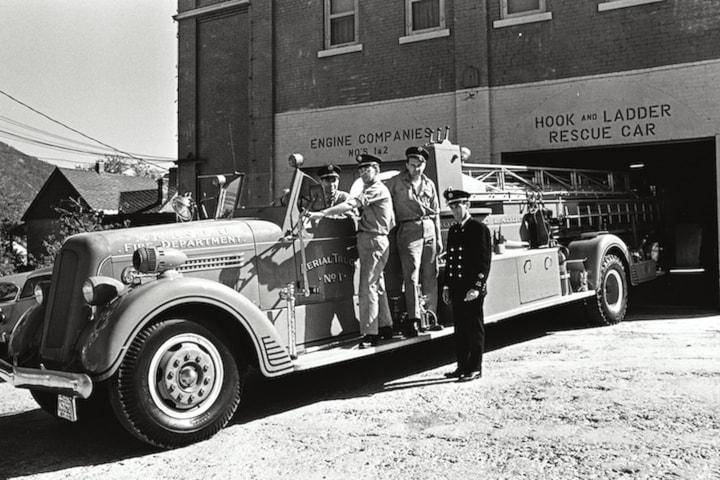Second of three parts marking the fire hall’s centennial
1) The Nelson Fire Department, now Nelson Fire and Rescue, has had 18 chiefs since the city’s incorporation in 1897. Longest serving was Elwyn Owens (1954-73), under whom the department won numerous national fire safety and prevention awards but ironically also suffered its deadliest fire, when the Strathcona Hotel burned, taking six lives. Owens was Citizen of the Year for 1965.
2) Harry Sommerville was the first Nelson native to become chief. He and present chief Simon Grypma are among the longest serving members in the department’s history: Sommerville was a volunteer from 1952 to 1958 and full-time from 1967 to 1992. Grypma joined as a volunteer in 1976 and went full-time two years later. Retired chief Randy Brieter also spent close to 30 years with the department.
3) When Owens retired, it ended a long tradition of fire chiefs living in the hall. However, volunteers, mainly those going to Selkirk College, continued to live there into the late 1980s. Rent was free but in the early days they were pretty much on call around the clock. Sommerville recalls moving in as a volunteer in 1952 and staying two or three years. Grypma says when he started in the 1970s, nine men still lived upstairs.
4) The hose tower was decommissioned decades ago with the introduction of electric dryers. The chief’s office is now in the tower’s base and there’s another office on the second floor. All the hardware used to hang hoses is still there. The former ambulance station, built in 1984 and vacated in 1992, now stores trailers for hazardous material response and sprinkler equipment for wildfire response.
5) Nelson had a somewhat mysterious second fire hall which opened in 1899 on Observatory Street between Ward and Josephine to complement the first hall at the corner of Josephine and Victoria and provide faster response to Uphill. The hall seems to have been rebuilt and expanded in 1908 but what became of it after the present hall opened five years later is unknown.
6) The completion of the present fire hall coincided with the installation of a new electric alarm system. Thirty-five boxes were scattered throughout town. Tripping the switch notified the fire hall and a gong relayed the call’s location through simple code. For instance, two bells, a pause, and three more bells meant box 23.
To combat false alarms, dye was placed on the boxes and local teachers knew any student caught with green fingers had likely been up to no good. The punishment was spending a Saturday polishing fire trucks. The boxes were finally retired in 1980 even though they still worked well (a couple are in the fire hall’s museum).
7) Remember the lime green fire trucks of the 1980s? Nelson wasn’t the only place that had them. They were purchased in the name of improving safety, since red trucks were hard to see at night. Unfortunately, many people didn’t know what to make of them and mistook them for utility vehicles. While nighttime accidents decreased, daytime accidents increased. Nelson and many other departments have since returned to fire engine red.
8) Nelson’s volunteer fire department became partly paid in 1901 with a full-time chief, assistant chief, and teamster plus ten volunteers who each received a monthly stipend of $15, less $2 for missing a call. By 1922, the paid staff had grown to five with the addition of two more drivers. By 1951, there were 14 full-time members when amid much controversy their ranks were trimmed to eight supplemented by 30 volunteers. Today the department consists of the chief, assistant chief, a fire prevention officer, two shift captains, six firefighters, a secretary-dispatcher and 21 on-call auxiliaries. While the department still awaits its first full-time female firefighter, it does have one amongst the auxiliaries.
9) In time for the fire hall’s centennial, firefighters are restoring one of its brass poles, of which there were originally two and later three. First to go was the one near the back of the hall where the horses were stabled, which was removed to allow for a new interior staircase. The one next to the alarm room was taken out when an exhaust system for the trucks was installed.The last pole was retired in 1993 because it impeded a doorway, but it’s still there and will soon be returned to active use.
10) Although it doesn’t appear in the earliest photos of the building, at some point the two main bays had signs placed above them reading “Engine Companies No. 1 and 2” and “Hook and Ladder/Chief’s Car.” The latter later read “Rescue Car No. 3.” Another current project will see the lettering returned as well as the fire hall’s date of construction placed above the main door.
